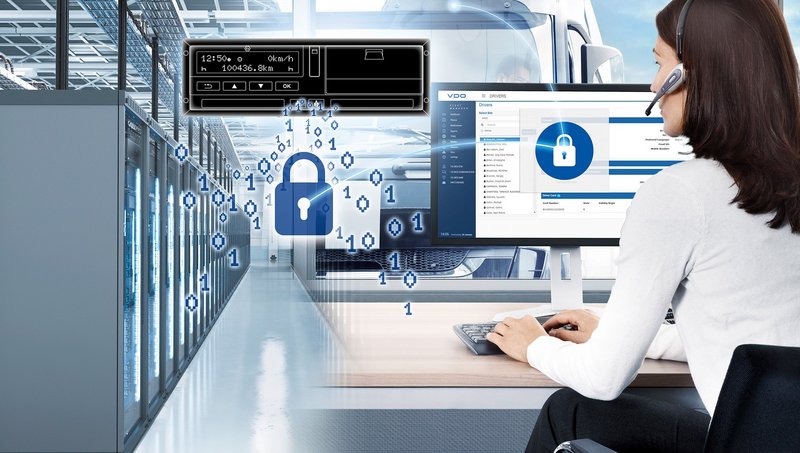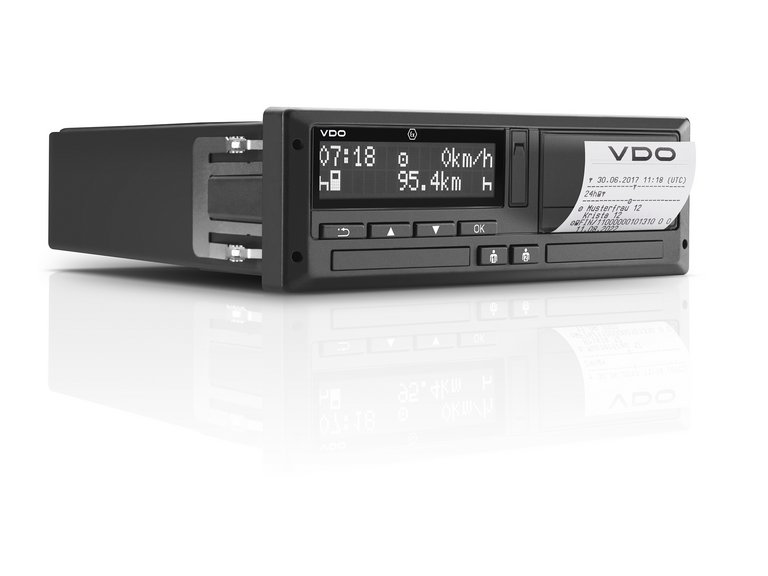Smart data, smart DTCO – how the smart tachograph becomes a problem solver
- Informative, trustworthy and tamper-proof – data generated by the smart tachograph can help to meet the challenges of the industry – and of society
The transport and logistics industries have become increasingly aware that digitalization and new technologies not only present challenges, they also form the foundation for long-term success – and one crucial element here is of course data. However, the data provided must be accurate and appropriate if a process is to succeed and ultimately create added value. This topic has often been discussed in the industry. However, questions about the secondary qualities of data, such as security, clarity and reliability, have not been asked as frequently. After all, no one would base a billing process on data if the origin is unclear and the method through which it has been acquired is more or less unknown. If accurate data is available, radically new digitalization potential can be developed, and challenges that could previously only be solved at enormous expense can then be tackled more efficiently.
The Mobility Package I recently adopted by the European Union is an excellent example of how reliable data can help to solve current problems such as the control of cabotage. In this case, reliable data from the second-generation smart tachograph (known at Continental as DTCO 4.1) helps to determine how many trips have already been made outside the home country. From Continental’s point of view, however, this is only the first of many possible cases in which reliable tachograph data can support the worlds of government and business.
Integrated into a network of various communication and sensor technologies, the digital tachograph also provides a solid basis for
solving challenges in social policy and transport policy,
more efficient fleet management that extends far beyond the capabilities of VDO TIS-Web, Continental’s solution for archiving and fleet management,
enhancing microservices, which enable commercial vehicle fleet service providers such as leasing companies, insurance companies, software providers for payroll accounting and many others to offer value-added services based on reliable (live) data.
Here are a few examples:
Adopted
Cabotage and posting of workers: Border crossings are documented
The topic is not new, but it has become increasingly urgent in recent years: the cabotage and posting of professional truck drivers. The EU’s Mobility Package I is aimed at ensuring fair competition in the European domestic market – and the DTCO 4.1 will play a key role in the implementation of the legal requirements since it will use satellite positioning and integrated maps to record border crossings in the future. In this way, it will enable the authorities to monitor the applicable regulations more efficiently, since in case of doubt they will be able to see how many trips both vehicle and driver have made and when and in which countries these trips took place. The next-generation smart tachograph is one of the first industrial applications to support not only GPS and Glonass but also the European Galileo signal (OSNMA). OSNMA uses an authentication service that prevents positional data from being manipulated or falsified.
Continental’s proposal
Load control: Total weight always available
Regular load measurement will become mandatory for commercial vehicles in Europe from 2021 and fleet operators must then provide weight data for the current trip when requested. The rules will become even more stringent in 2024, because the weight measurement procedure must produce even more accurate results (maximum 5% deviation allowed between the measurement and the actual weight) and data transmission must also meet security level Common Criteria EAL 2. Continental’s smart tachograph can also provide support here – in a matter of seconds, it receives the data via a CAN bus from the control sensors that determine the load status on the individual axles. The tachograph then provides this data with a signature that can be uniquely assigned to the particular vehicle. It can then be transmitted via the DSRC antenna (Dedicated Short Range Communication) to the requesting authority staff.
The advantage of the VDO tachograph in this process is that the intelligence of the DSRC antenna is built directly into the tachograph, so the load weight information must necessarily be routed via the DTCO on its way from the axle sensors via the CAN bus to the DSRC antenna. The security level upgrade for the data flowing in this way is therefore wholly automatic. This is a significant advantage for companies, since neither extra effort nor additional costs are involved in the transmission of data.
Continental’s proposal
Toll billing based on weight: Fair and efficient
Following the recording of weight, the digital tachograph also offers possibilities for more accurate and fairer toll billing for commercial vehicles. As the weight on a vehicle axle increases, so does the load on the road, resulting in wear and tear on the surface. This is why commercial vehicles are regularly criticized for generating more costs for road maintenance than they cover through their toll payments.
As soon as it is possible to determine the actual total vehicle weight with sensors, the measurement results can be transferred into a very accurate (and significantly fairer) calculation of the toll to be paid. The tachograph can transmit this weight data quickly and securely to the toll station via DSRC.
Continental’s proposal
Goodbye to toll boxes in commercial vehicles: OTA transmission with the tachograph
Thanks to its DSRC interface, the smart tachograph could also be the key to harmonized European toll collection in the future, since it calculates and records the charges incurred and sends them to the toll charging locations in EETS standard. This means that fleet managers would no longer have to invest in a large number of different toll boxes and devices; they could handle the entire toll billing process using the existing digital tachographs – and the many small toll boxes that can meanwhile be found in trucks used throughout Europe could also be eliminated.
Implemented
TIS-Web Connect: Importing of data from other systems into VDO’s fleet management software
It’s not only government that can benefit from solutions based on reliable data from the tachograph. Continental offers special interfaces to support transport companies in using the reliable tachograph data for their own fleet management. Thanks to the intelligent TIS-Web Connectinterface, fleets that use the VDO TIS-Web software for their fleet management can transfer data from other suppliers’ systems to their own TIS-Web platforms – a great advantage for mixed fleets that do not have a uniform software solution. Fleet managers in Italy, for example, can now integrate the Telepass KMaster telematics platform into TIS-Web, enabling them to view and manage toll bills, location information, vehicle data and more in one system.
Implemented
TIS-Web Extract: Exporting data from the tachograph via the TIS-Web cloud
With the TIS-Web Extract interface, Continental enables third-party systems to extract data records from TIS-Web and reuse them. Driver data and vehicle data are just some examples of the types of data that many companies are already taking from the tachograph via the TIS-Web cloud. TIS-Web Extract can be used to automate bills or payroll accounting, for example. Completely new business models based on telematics data from the tachograph are also conceivable. Continental e.g. provides automated data on driving and rest times as well as GPS data for the TIMOCOM tracking application via the TIS-Web Extract interface. Here the data is also refined, i.e. Continental makes it available in a file format that allows it to flow automatically into TIMOCOM’s Smart Logistics System. This enables TIMOCOM to provide its customers with much more precise and up-to-date information on the availability of drivers and vehicles who can pick up cargo when requested to do so.
This press release is available in the following languages:

Valerie Libercka
Media Spokesperson Smart Mobility
Continental Automotive


